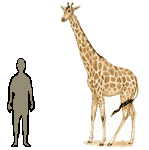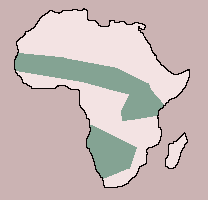Giraffe

| Class: Mammalia:
Mammals |
Diet: Leaves, buds,
fruits |
| Order:
Artiodactyla: Even-toed Ungulates |
| Size: body:3
- 4 m (9 3/4 - 13 ft), tail: 90 cm - 1.1 m (35 1/2 in - 3 1/2 ft) |
| Family: Giraffidae:
Giraffes |
Conservation Status: Vulnerable |
| Scientific Name:
Giraffa camelopardalis |
Habitat: savanna |
| Range:
Africa, south of the Sahara |
 The
giraffe, with its long legs and its amazingly long neck, when erect stands
up to 3.3 m (11 ft) at the shoulder and nearly 6 m (19 1/2 ft) at the crown.
Its characteristic coloration of a light body and irregular dark spots
is very variable, both geographically and between individuals; some animals
may be almost white or black, or even unspotted. Both male and female have
skin-covered horns, one pair on the forehead and sometimes a smaller pair
farther back, on the crown. Some animals have yet another small horn, or
bump, between these pairs. The tail ends in a tuft of long hairs. The
giraffe, with its long legs and its amazingly long neck, when erect stands
up to 3.3 m (11 ft) at the shoulder and nearly 6 m (19 1/2 ft) at the crown.
Its characteristic coloration of a light body and irregular dark spots
is very variable, both geographically and between individuals; some animals
may be almost white or black, or even unspotted. Both male and female have
skin-covered horns, one pair on the forehead and sometimes a smaller pair
farther back, on the crown. Some animals have yet another small horn, or
bump, between these pairs. The tail ends in a tuft of long hairs.  Gregarious animals, giraffes usually live in troops of up to 6, sometimes
12, and may occasionally gather in larger herds. A troop consists of females
and their offspring, led by a male. Males fight for possession of females,
wrestling with their heads and necks. The troop ambles around its territory,
feeding mostly in the early morning and afternoon on the foliage, buds,
and fruits on the top of acacia and thorn trees. The giraffes may also
eat grass, other plants, and grain crops. At midday, giraffes rest in shade
and at night lie down for a couple of hours or rest standing. Females give
birth to a single offspring, rarely twins, after a gestation of over a
year -- usually 400 to 468 days. Births invariably occur at first light.
The young is suckled for 6 to 12 months and continues to grow for 10 years.
Gregarious animals, giraffes usually live in troops of up to 6, sometimes
12, and may occasionally gather in larger herds. A troop consists of females
and their offspring, led by a male. Males fight for possession of females,
wrestling with their heads and necks. The troop ambles around its territory,
feeding mostly in the early morning and afternoon on the foliage, buds,
and fruits on the top of acacia and thorn trees. The giraffes may also
eat grass, other plants, and grain crops. At midday, giraffes rest in shade
and at night lie down for a couple of hours or rest standing. Females give
birth to a single offspring, rarely twins, after a gestation of over a
year -- usually 400 to 468 days. Births invariably occur at first light.
The young is suckled for 6 to 12 months and continues to grow for 10 years.
  
|

